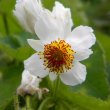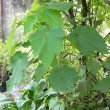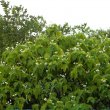Sparrmannia africana
| Botanical Name | Sparrmannia africana |
|||||||||||||||||||||
| Family | Malvaceae - The hibiscus and cotton family. |
|||||||||||||||||||||
| Pronunciation | spar-MAN-ee-uh af-ri-KAHN-uh |
|||||||||||||||||||||
| Common Name(s) |
English: Stock Rose; African Hemp; African Linden
Afrikaans: Stokroos
|
|||||||||||||||||||||
| Plant Group |
|
|||||||||||||||||||||
| Plant Size |
|
|||||||||||||||||||||
| Position |
|
|||||||||||||||||||||
| General Information |
|
|||||||||||||||||||||
| Specific Information | Sparrmannia africana is a large, often multi-stemmed shrub which may grow or be shaped into a small tree. It forms a rounded, compact shape. The very large, bright green, heart-shaped leaves are softly textured and hairy. The hairs from the leaves can cause irritation and a rash. The flowers resemble those of a rambling rose. The flower has a trigger mechanism for actively pressing pollen onto visiting insects and it is quite fascinating to watch the stamens visibly move when gently touched. Sparmannia africana is commonly grown in Europe and the USA as a house plant. |
|||||||||||||||||||||
| Ad Break | ||||||||||||||||||||||
| Flowers | ||||||||||||||||||||||
| Description | four rose-like petals surrounding a cluster of bright yellow stamens tipped with purple-red anthers |
|||||||||||||||||||||
| Season |
|
|||||||||||||||||||||
| Colour |
|
|||||||||||||||||||||
| Growth Rate |
|
|||||||||||||||||||||
| Plant Uses |
|
|||||||||||||||||||||
| Distribution and Habitat | in the Western Cape and Eastern Cape, from Knysna to Port Elizabeth, on rocky hillsides and margins of evergreen forests |
|||||||||||||||||||||
| Planting Suggestions | Sparrmannia africana grows in most soils but the addition of compost at planting will greatly speed up growth. In inland gardens it is best planted with some shade and protection from midday sun and winter frost. If cut down by frost it usually recovers rapidly. Water well and regularly for the first year and moderately thereafter. Supply a yearly dressing of compost and keep well mulched. The plant tolerates pruning to shape and this should be done after flowering and seeding, but before winter sets in. Yellowing leaves indicate heat and a lack of water. Good air circulation around the plant will help to prevent the development of diseases and fungi that thrive in overly humid conditions but the shrub will not tolerate very strong or dry wind. If grown indoors, Sparmannia will need bright light and yearly re-potting in early spring, using a well-drained potting mix. |
|||||||||||||||||||||
| Lorraine's Garden Notes | I have had my Sparmannia for almost three years but it had a rather stunted youth in a bag and almost expired a few times. Where to plant it on my ever-windy hilltop, out of reach of Berg winds and blazing sun, but close enough for ease of watering? After much trial and error I planted it in an open shade-house under 80% shade netting where it is a least protected from the worst of the wind. It has grown very fast since then but this position is not ideal, as the plant receives insufficient sunlight. |
|||||||||||||||||||||
| Medicinal Uses | During the late 1800's the fibre from this species was produced commercially but was found to be of inferior quality. |
|||||||||||||||||||||
| Ad Break | ||||||||||||||||||||||









Comments
sparmannia africana
I have 3 of these growing in my garden. Tolerate all but the deepest darkest shade. One of mine is growing about 1 metre away from a Brazilian Pepper tree. they are fast growing. they flower in the second half of winter from about July. I cut mine back hard to about 1 metre high in spring to contain their height to about 2 metres, and to encourage bushiness otherwise they have a tendency to get leggy. foliage is large leaved and lighter green so the mix well with dark strap leaved Clivia, which need complete shade. This shrub will grow in sun but actually does better in shade, so it also good for those spots which might get full blast of the afternoon summer sun, but nothing in winter.
Growing Sparmannia africana
Hi Lucy
Thanks for your information. Between Berg wind and howling gales, I have not had much luck with Sparmannia and am now growing it in an enclosure covered with 80% shade netting. It is growing well now but will need regular trimming as you suggest. It would be nice to know where you live as the plant is obviously happy in your part of the country.
Regards
Lorraine
Discuss this plant
Share knowledge, ask a question or give an experience.